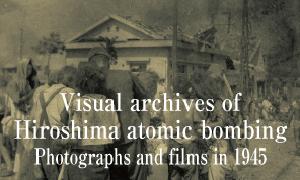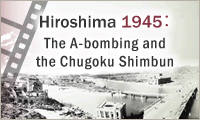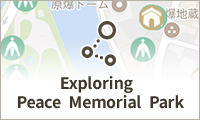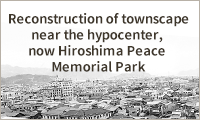Documenting Hiroshima 80 years after A-bombing: May 27, 2016, U.S. President Obama visits Hiroshima
May 29, 2025
President avoids mention of responsibility for atomic bombings
by Michio Shimotaka and Minami Yamashita, Staff Writers
On May 27, 2016, three survivors of the atomic bombing, representing the Japan Confederation of A- and H-Bomb Sufferers Organizations (Nihon Hidankyo), attended a ceremonial event held at Peace Memorial Park, located in Hiroshima’s Naka Ward, in commemoration of U.S. President Barack Obama’s visit to the city. As the U.S. president paid tribute by offering flowers to the Cenotaph for the A-bomb Victims, the three survivors looked on from guest seating that had been set up in front of the cenotaph. In his subsequent speech, the three anticipated that Mr. Obama would express the determination to work to eliminate nuclear weapons as a sign of his taking responsibility for the atomic bombings and offering apology to the victims.
Handshake of reconciliation
Terumi Tanaka, 93, then-secretary-general of Nihon Hidankyo and a resident of Niiza City, Saitama Prefecture who is a survivor of the atomic bombing of Nagasaki, seated beside Mikiso Iwasa, the group’s co-chair at the time who had lost his mother and younger sister in the atomic bombing of Hiroshima and died in 2020 at the age of 91, faced toward Mr. Obama in the third row of seats. Despite being unable to catch parts of the first half of the speech, Mr. Tanaka felt that Mr. Obama had shown “good insight” in the section of his remarks about how advances in science and technology had brought about the nuclear age.
Mr. Obama’s 17-minute speech was also marked by his mention of the importance of morality. “Technological progress without an equivalent progress in human institutions can doom us,” said the U.S. president. Touching on the countless numbers of A-bomb victims and “hibakusha,” he concluded with the words, “Hiroshima and Nagasaki are known not as the dawn of atomic warfare, but as the start of our own moral awakening.”
After finishing his remarks, Mr. Obama walked up to Sunao Tsuboi, then-co-chair of Nihon Hidankyo and chair of the Hiroshima Prefectural Confederation of A-bomb Sufferers Organizations (Hiroshima Hidankyo) who died in 2021, sitting in the front row of guest seats, and shook his hand. Through an interpreter, Mr. Tsuboi delivered his message to Mr. Obama. “I will never give up the work of elimination of nuclear weapons. Let’s overcome resentment and work hard together for humankind,” said Mr. Tsuboi. Mr. Obama is said to have responded by repeating the words, “Thank you.”
As being among those memorialized, Mr. Obama also touched in his remarks on U.S. soldiers captured as prisoners of war who died in the atomic bombing. Mr. Obama embraced Shigeaki Mori, 88, an A-bomb survivor living in Nishi Ward who has long studied the American POW issue. However, throughout the entire visit, Mr. Obama did not offer any words of apology for the atomic bombings.
After the event, Mr. Tanaka was busy taking questions at a press conference and other matters, but on his way back home by Shinkansen bullet train the following day, he finally had a chance to open a newspaper and read the full text of Mr. Obama’s speech. When his eyes caught the beginning, “Seventy-one years ago, on a bright cloudless morning, death fell from the sky…,” he thought, “That’s totally unacceptable. He spoke as if the atomic bombing had been something akin a natural disaster. Clearly, he had not been thinking about America’s responsibility in dropping the atomic bombs.”
The Nihon Hidankyo organization’s “Basic demands from A-bomb survivors,” a document released in 1984, also contains demands the group made of the U.S. government, including calling on the nation to apologize to the A-bomb survivors in recognition that the dropping of the atomic bombs on Hiroshima and Nagasaki were inhumane as well as a violation of international law. As evidence of that apology, the document called on the United States to play a leading role in the elimination of nuclear weapons.
Did not listen to testimony of experiences in atomic bombing
On the eve of Mr. Obama’s visit to Hiroshima, Mr. Tanaka had hoped that the U.S. president would deliver “a strong message of nuclear abolition as a sign of apology.” Nihon Hidankyo had sent a letter of request to the White House in the United States, in which was written, “We would like you, Mr. President, to listen to the story of a hibakusha who experienced a living hell indescribable in mere words and have the willingness to realize a world without nuclear weapons.”
Staying at the Hiroshima Peace Memorial Museum for 10 minutes, Mr. Obama did not listen to an account of the atomic bombing by an A-bomb survivor. His visit to Hiroshima was felt by some to be “political theater,” far removed from any commitment to come to terms with the inhumane devastation caused by the atomic bombing.
Meanwhile, some A-bomb survivors recognized his visit. Mr. Mori, one such survivor, said, “The visit gave people around the world an opportunity to think deeply about nuclear weapons and human life.” The focus then was on how Mr. Obama would act as a result of the visit to the A-bombed city over the next half a year before leaving office in January 2017.
Around one month and half after his visit, a U.S. newspaper reported that the Obama Administration was considering a “no first use” policy regarding nuclear weapons, in which the United States would pledge not to use nuclear weapons prior to any nuclear attack by another country. However, the policy was postponed. The reason for the delay was said to be because of concerns expressed by U.S. allies such as Japan about “weakened nuclear deterrence” and strong opposition against the policy within the U.S. administration.
In December 2016, Mr. Obama met with then-Japan Prime Minister Shinzo Abe on a joint visit to Pearl Harbor in the U.S. state of Hawaii, where the Pacific theater of World War II had begun. The two leaders emphasized “reconciliation” through the alliance that had been built between the United States and Japan, two former enemy nations. The following month, Donald Trump assumed the presidency of the United States. On Twitter (now known as “X”), Mr. Trump sent out the message, “The United States must greatly strengthen and expand its nuclear capability.”
(Originally published on May 29, 2025)








